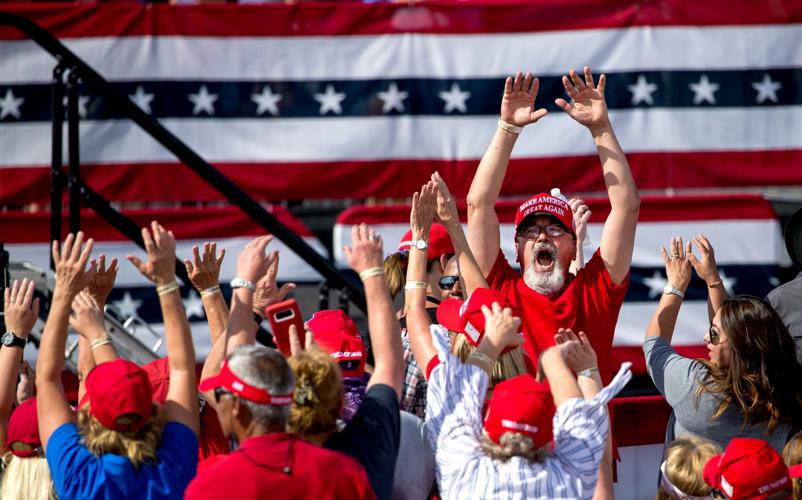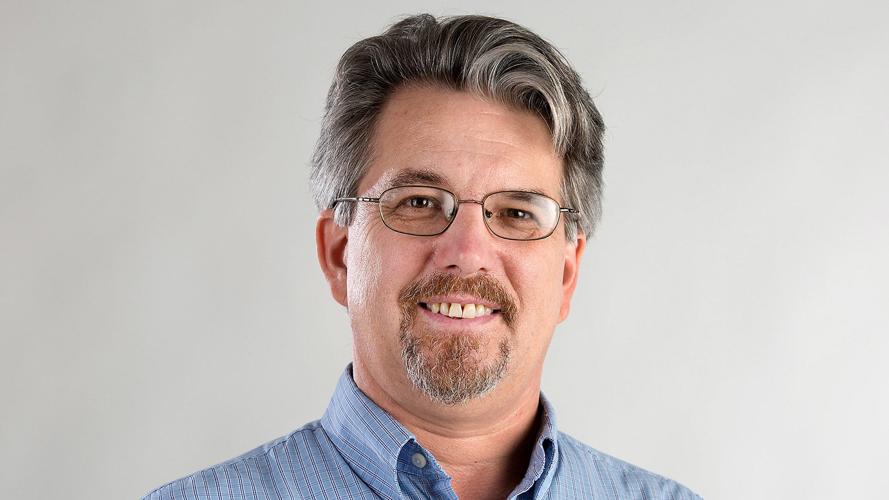President Trump sent the message Monday, directly and indirectly, that the pandemic is not that big a deal anymore.
After all, he gathered thousands of people for rallies in Prescott and here in Tucson, packed together without even a mask requirement, at a time when infections are rising again.
That said a lot on its own — it flagrantly disregarded public-health guidelines on large gatherings and mask-wearing. He also repeatedly downplayed its seriousness in his comments:
“The pandemic is rounding the turn. Vaccines are coming. And I look fine, don’t I?”
“The vaccine will end the pandemic. But even without the vaccine, the pandemic is ending. It’s going to end.”
“People are pandemic’d out. You know that? They’re pandemic’d out.”
It’s nice to feel optimistic, which is the feeling the president tried to communicate about COVID-19 during his Arizona swing. It’s also what the president tried to do from the beginning of the pandemic, as we know from Bob Woodward’s interviews. By trying to avoid panic, he also misled the public, or at least part of it, into thinking the pandemic is not that big a deal.
Yes, “we will get back to normal life,” as the president said.
But not all of us will be there when we arrive. Almost 6,000 Arizonans have died, and thousands more could if we’re not careful.
So it’s best to be, not optimistic nor pessimistic, but realistic.
With about an hour before President Trump's scheduled arrival to the Tucson Jet Center, here's a look at what the rally looks like. More info on the campaign stop: http://tucne.ws/1fxx (Video: Jasmine Demers / Arizona Daily Star)
The president’s rhetoric in Tucson only veered from unrealistic optimism about the coronavirus when it boosted his own record.
“We built the greatest economy ever,” Trump said. “We had to close it down — we saved millions of lives by doing what we did. Then we built it back up.”
“To battle the China virus we launched the largest mobilization since World War II. Our early and aggressive action saved more than 2 million lives.”
In both cases, Trump was referencing worst-case scenarios in which we did nothing to respond to the virus. If we had done nothing, we might have arrived at 2 million or more lives lost in the first year. Instead, we’re at about 221,000 in the United States — a huge number on its own.
Beating the “do-nothing” option is really a low threshold for success. On the issue of masks, for example, Trump has repeatedly sent mixed messages. He told gathered reporters Monday in Prescott: “I’m OK with masks. I like it. I think it’s good. A lot of people like it.”
But then he rarely ever wears them and does not require them even at his ill-advised mass rallies, including Monday’s in Tucson, where the crowd was largely maskless.
A recent Centers for Disease Control study on Arizona showed how the state’s COVID-19 cases spiked after emergency measures were lifted in mid-May, then dropped sharply after cities and counties started imposing mask requirements in mid-late June.
Before that improvement, we had scary weeks of June and July, when cases surged and our hospitals overflowed. Then after the mask mandates took effect, the positivity rate for diagnostic tests dropped sharply.
We had a manageably low positivity rate of about 4% for five consecutive weeks, from late August to early October. But then the rate rose to 6% the second week of October and 8% the third week.
The “Rt,” a measure of effective spread that the governor’s office frequently cited in July and August when it was low, has risen in Arizona to about 1.10, meaning the spread is accelerating here now.
Pima County and Yavapai County, where Prescott is located, have been two of Arizona’s better performing counties recently. We’ll be lucky if they stay that way after the president’s irresponsibly optimistic rallies.
Mixed message on McSally
During his rallies, Trump repeatedly encouraged people to vote for Sen. Martha McSally, who is facing a tough election challenge by Democrat Mark Kelly.
But while Trump let Gov. Doug Ducey speak in Prescott and Tucson, he only let McSally speak in Prescott, not in Tucson where she lives.
And he referred to the former fighter pilot as “honey” and “darling.” Ouch.
“We’re not going to take her time or anything, but Martha McSally is here,” Trump said, as if McSally had something else to do while he was on stage.
“She’s saving your 2nd Amendment,” he added. “She’s been a great, great senator. Martha, come here, honey.”
In Prescott, introducing Arizona GOP chair Kelli Ward, Trump also said something intriguing about Ward: “She would have been, if she didn’t have three, four people running at the same time, she would have been your senator. I hate to say it. She would have been your senator.”
The comment was a slight to McSally, who defeated Ward in 2018 to win the Republican nomination. McSally went on to lose the general election to Democrat Kyrsten Sinema. He was also probably wrong — it’s unlikely Ward would have done better than McSally against Sinema. (After McSally’s loss, Ducey appointed her to Arizona’s other Senate seat after John McCain died.)
Perhaps Trump is seeing the polls that show McSally losing to Kelly and preemptively distancing himself. Or maybe he didn’t like it when McSally wouldn’t answer directly a question about whether she was proud of her support for Trump during a senatorial debate.
Ducey digs deep
Ducey, on the other hand, has embraced Trump as tightly as any Arizona elected official.
He was practically shouting when Trump invited him to the microphone in Tucson.
“Donald Trump will win Arizona!” Ducey proclaimed. “Donald Trump will be re-elected president of the United States!”
The crowd of Trump supporters might not have been so supportive of Ducey as he was of Trump. The audio of the event picked up a smattering of what sounded like boos when Trump introduced him, and Trump seemed to acknowledge that.
“This guy has been a great governor. I don’t know if you like him or not. I don’t care. He’s been a great governor.”
It would not be surprising if there were some boos — some Republicans have criticized Ducey for his use of executive authorities in response to the pandemic.
Photos: President Donald Trump campaign rally in Tucson
President Trump in Tucson
Updated
President Donald Trump speaks during a campaign rally at Tucson Jet Center, 6720 S. Plumer Ave., in Tucson, Ariz., on October 19, 2020.
President Trump in Tucson
Updated
While waiting for President Trump to speak, Rafael Leidy, right, starts a wave with the crowd during a "Make America Great Again" campaign rally at Tucson Jet Center, 6720 S. Plumer Ave., in Tucson, Ariz., on October 19, 2020.
President Trump in Tucson
Updated
President Donald Trump speaks during a campaign rally at Tucson Jet Center, 6720 S. Plumer Ave., in Tucson, Ariz., on October 19, 2020. More than 2,000 President Trump supporters wearing red hats, Trump-Pence shirts, American flag pants and shirts gathered at the event.
President Trump in Tucson
Updated
President Donald Trump, bottom right, waves to supporters after speaking at a campaign rally at Tucson Jet Center, 6720 S. Plumer Ave., in Tucson, Ariz., on October 19, 2020.
President Trump in Tucson
Updated
A supporter wears an American flag cowboy hat during a Trump campaign rally at Tucson Jet Center, 6720 S. Plumer Ave., in Tucson, Ariz., on October 19, 2020. More than 2,000 President Trump supporters wearing red hats, Trump Pence shirts, American flag pants and shirts gathered at Tucson Jet Center for the event.
President Trump in Tucson
Updated
President Donald Trump speaks during a campaign rally at Tucson Jet Center, 6720 S. Plumer Ave., in Tucson, Ariz., on October 19, 2020.
President Trump in Tucson
Updated
A supporter makes a heart shape while President Donald Trump speaks during a campaign rally at Tucson Jet Center, 6720 S. Plumer Ave., in Tucson, Ariz., on October 19, 2020.
President Trump in Tucson
Updated
A fan records President Donald Trump during a campaign rally at Tucson Jet Center, 6720 S. Plumer Ave., in Tucson, Ariz., on October 19, 2020.
President Trump in Tucson
Updated
Lavon Lohse, center, chants "four more years" with another supporter during a campaign rally at Tucson Jet Center, 6720 S. Plumer Ave., in Tucson, Ariz., on October 19, 2020.
President Trump in Tucson
Updated
President Donald Trump holds up a fist after speaking at a campaign rally at the Tucson Jet Center, 6720 S. Plumer Ave., in Tucson, Ariz., on October 19, 2020.





